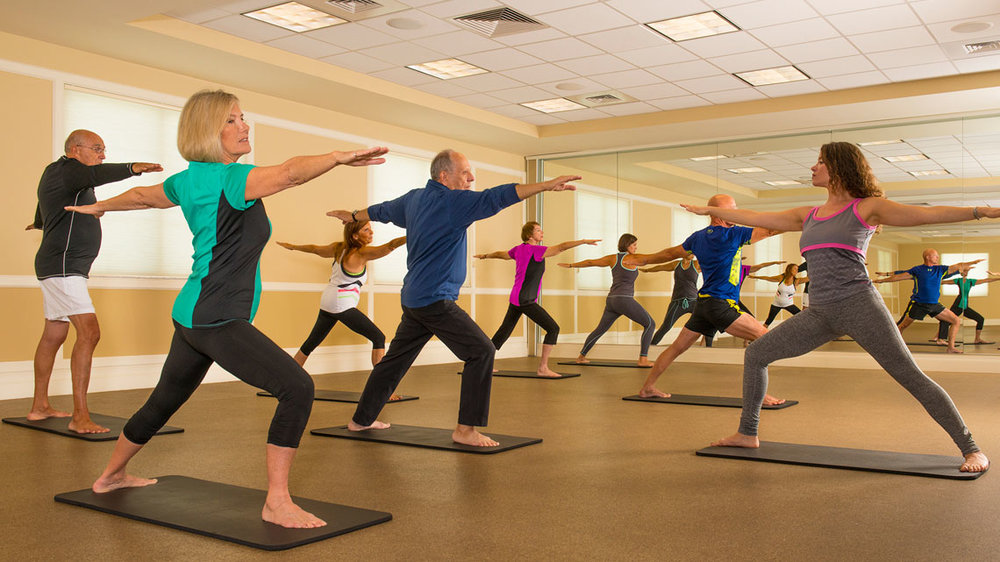When it comes to fitness, just getting up and moving is better than nothing—whether you hit the gym, go for a run, or livestream fitness program workouts you can do in your home, moving and challenging your body (and working up a good sweat) has major health benefits. But if an added goal of yours is to build muscle, get stronger, or improve your cardiovascular fitness, actually sticking to a regular routine or following a program can make a world of difference.
While trying something new beats boredom and keeps your body working in new ways, it also makes it tough to ever find your groove. Just hitting up a random class every now and then but never really committing fully to anything makes it hard to set and reach goals. There are a few reasons why.
Jumping around haphazardly from one class to another makes it impossible to really figure out if a workout is right for you.
“The first time you go to any studio or class, you’re probably getting 50 percent of the benefits from that particular workout,” Kira Stokes, NYC-based celebrity trainer and creator of the Stoked Method, tells SELF. “So much of your mind isn’t focusing on the physical part but more on the mental part of what you should be doing, who you’re listening to, what’s their coaching style. You’re figuring out the instructor’s style and the format of the workout,” she explains. If you’ve ever taken a new fitness class, you know that feeling of being just one step behind. If you never go back, you’ll never actually know if you like it.
Stokes compares it to a relationship: “If you don’t give yourself enough time to try a fitness method or philosophy, you’re not giving it a fair chance,” she says. “You need to allow your body to understand and let a class or program resonate with it,” so you can decide whether or not it’s right for you.
When you’re new to exercise, a lack of direction also makes it very tough to improve and see your progress. As a beginner exerciser, you learn basic skills. “You have to go through and learn that skill well enough to be able to demonstrate your current strength level in it first, let alone get better at it and get stronger,” Ryan Hopkins, personal trainer, co-founder of Soho Strength Lab, tells SELF. Getting comfortable in a specific type of class or workout takes time, and when you’re only doing it here and there, it’s tough to ever really get better consistently and progress.
The biggest reason to follow a fitness program is so that you’re challenging your body consistently in the right ways to meet your goals. This is how your body adapts and changes, ultimately improving your fitness.
If you’re trying to make noticeable improvements to your body, whether you’re looking to be able to get up stairs without feeling winded or you’re training for your first marathon, it’s important to gradually add more work and rev up the intensity. The idea of challenging your muscles bit by bit, adding more intensity over time, is known as progressive overload, and it’s one of the foundational principles of fitness.
“Progressive overload means that the body is consistently challenged beyond its previous capacity,” Brad Schoenfeld, PhD, assistant professor in exercise science at Lehman College in New York, tells SELF. “For example, you can increase the volume of training (i.e. number of sets or reps), you can decrease the rest intervals, you can train with greater effort, etc.,” he explains.
Pushing your body to adapt to ever increasing intensity levels or exercise stimuli is a major driving force behind continuous gains in strength, endurance, or overall fitness levels. But Schoenfeld notes that the way your body improves and changes follows the principle of specificity, which means that you get better at doing the exercises that you’re training to do. If you train by lifting challenging weights, then you will be able to lift heavier weights over time. If you run longer distances over time, then eventually you’ll be able to complete a 5K, half-marathon, or whatever your goal may be. “A program must be specific to a person’s needs and goals,” he says. “If it’s properly designed in that manner, you need to do it consistently over a period of time to see results.”
But that doesn’t mean you should be doing the same exact workout every day.
“When I say you should stick to one program, I want to be clear, I’m not saying only go to SoulCycle,” Stokes says—or any other single type of workout. Your regimen should include a variety of exercise types that challenge your body in different ways in order to ensure that your body is balanced and your fitness program is well-rounded. That could mean committing to a selection of different classes—like HIIT and yoga as well as cycling. This way, you’re getting a mix of strength exercise, stretching and flexibility, and cardiovascular exercise—all important aspects of fitness.
If you’re following a program from home, the same principles apply. The program should have structure but never just be the same old workout over and over again.
When you’re thinking about what your own fitness program should look like, make sure you’re showing all your body parts some love. For example: Plan to run every Monday, go to your favorite barre class every Tuesday, a HIIT class on Thursday, and yoga on Friday. By choosing a variety of workouts, you’re working your body in multiple ways and hitting on everything from strength, to cardiovascular work, to flexibility. The key is finding those specific classes you really like, that challenge you, and that you show up at week after week.
It also helps to appreciate that committing to a consistent routine comes with added benefits, like trainers and class-goers that are along for the ride and help keep you motivated.
Another benefit of taking the same classes week after week is that you form a relationship and sense of community with everyone else who shows up at the same time same place. Knowing your #fitfam will ask you why you weren’t in class is great motivation for not skipping. Being held accountable by others helps us let go of excuses and stay on track, and if you’re truly looking to make a change, that’s key. It can also be really fun and rewarding—and that’s how fitness should feel.
It’s important to recognize that when it comes to certain goals, exercise alone isn’t enough.
Working out regularly is great for your body and mind, and is and should be a goal unto itself. But if you have another specific goal—like losing weight, or lowering body fat percentage, or building muscle—your workouts are only part of the equation. Nutrition is also a vital part of losing or gaining weight, adding muscle, or burning fat. In fact, research shows that working out alone isn’t enough for weight loss—in part because people tend to overestimate the calories they burn during workouts and therefore eat more calories to compensate. There’s nothing wrong with this if your goal is health and you’re fueling your body with nutritious foods, but it can be counterproductive if you’re trying to lose weight.
Before you set a body composition goal, remember that losing weight, burning fat, or gaining muscle can be very difficult. Make sure your goals are realistic for you. For some people, six-pack abs aren’t just unrealistic—they’re impossible. Consider your own body type, as well as how much time and mental energy you’re willing and able to dedicate to a fitness and nutrition plan.
Remember that type of physical activity is good.
If you’re having trouble sticking to your routine—or if you just don’t feel like following a program—don’t sweat it too much. A specific fitness program is a great way to achieve a certain goal, yes, but it’s not necessary in order to be fit. Simply moving your body is a great achievement to celebrate.
In addition, if you’re not enjoying your program, maybe it’s time to try something different. A workout you enjoy is also one you’ll stick with over time—boosting your enjoyment as well as your results.
Additional writing and reporting by Stephanie Lee.





